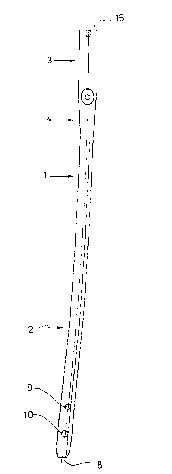Some of the information on this Web page has been provided by external sources. The Government of Canada is not responsible for the accuracy, reliability or currency of the information supplied by external sources. Users wishing to rely upon this information should consult directly with the source of the information. Content provided by external sources is not subject to official languages, privacy and accessibility requirements.
Any discrepancies in the text and image of the Claims and Abstract are due to differing posting times. Text of the Claims and Abstract are posted:
| (12) Patent: | (11) CA 2075534 |
|---|---|
| (54) English Title: | LOCKING NAIL FOR TREATING FEMURAL FRACTURES IN THE MEDIUM AND TROCHANTER REGION |
| (54) French Title: | CLOU DE VERROUILLAGE POUR LE TRAITEMENT DE FRACTURES DE FEMUR DANS LA REGION MOYENNE ET TROCHANTERIENNE |
| Status: | Expired and beyond the Period of Reversal |
| (51) International Patent Classification (IPC): |
|
|---|---|
| (72) Inventors : |
|
| (73) Owners : |
|
| (71) Applicants : | |
| (74) Agent: | SMART & BIGGAR LP |
| (74) Associate agent: | |
| (45) Issued: | 1999-01-26 |
| (22) Filed Date: | 1992-08-07 |
| (41) Open to Public Inspection: | 1993-02-10 |
| Examination requested: | 1994-10-05 |
| Availability of licence: | N/A |
| Dedicated to the Public: | N/A |
| (25) Language of filing: | English |
| Patent Cooperation Treaty (PCT): | No |
|---|
| (30) Application Priority Data: | ||||||
|---|---|---|---|---|---|---|
|
Locking nail for treating femural fractures in the medium
and trochanter region, wherein a proximal portion of the
nail to be positioned in the marrow space may be provided
with an oblique bore for positioning and guiding a femur
neck screw and the distal portion of the nail is provided
with at least a cross bore for receiving a bone screw,
wherein the distal nail portion comprises an open clover-leaf
profile including an axial longitudinal slot, a
transition portion joining a cylindrically closed proximal
nail portion with a distal nail portion having a smaller
diameter and that the axial longitudinal slot extends
substantially from the transition portion to the free
distal nail end.
Clou de verrouillage pour le traitement des fractures fémorales dans la région moyenne et du trochanter, dont une portion proximale à placer dans l'espace médullaire peut être fournie avec un orifice oblique pour le positionnement et le guidage d'une vis du col fémoral et dont la portion distale est équipée d'au moins un orifice transversal pour recevoir une vis à os, portion distale présentant un profil ouvert en forme de trèfle incluant une rainure longitudinale axiale, une portion de transition reliant une portion proximale du clou fermée en cylindre à une portion distale du clou ayant un diamètre inférieur, et que la rainure longitudinale axiale se prolonge substantiellement au-delà de la portion de transition jusqu'à l'extrémité distale libre du clou.
Note: Claims are shown in the official language in which they were submitted.
Note: Descriptions are shown in the official language in which they were submitted.

2024-08-01:As part of the Next Generation Patents (NGP) transition, the Canadian Patents Database (CPD) now contains a more detailed Event History, which replicates the Event Log of our new back-office solution.
Please note that "Inactive:" events refers to events no longer in use in our new back-office solution.
For a clearer understanding of the status of the application/patent presented on this page, the site Disclaimer , as well as the definitions for Patent , Event History , Maintenance Fee and Payment History should be consulted.
| Description | Date |
|---|---|
| Inactive: IPC from MCD | 2006-03-11 |
| Inactive: IPC from MCD | 2006-03-11 |
| Time Limit for Reversal Expired | 2003-08-07 |
| Letter Sent | 2002-08-07 |
| Grant by Issuance | 1999-01-26 |
| Inactive: Final fee received | 1998-10-09 |
| Pre-grant | 1998-10-09 |
| Notice of Allowance is Issued | 1998-05-22 |
| Notice of Allowance is Issued | 1998-05-22 |
| Letter Sent | 1998-05-22 |
| Inactive: Status info is complete as of Log entry date | 1998-05-19 |
| Inactive: Application prosecuted on TS as of Log entry date | 1998-05-19 |
| Inactive: IPC removed | 1998-04-30 |
| Inactive: First IPC assigned | 1998-04-30 |
| Inactive: IPC assigned | 1998-04-30 |
| Inactive: Approved for allowance (AFA) | 1998-04-29 |
| Request for Examination Requirements Determined Compliant | 1994-10-05 |
| All Requirements for Examination Determined Compliant | 1994-10-05 |
| Application Published (Open to Public Inspection) | 1993-02-10 |
There is no abandonment history.
The last payment was received on
Note : If the full payment has not been received on or before the date indicated, a further fee may be required which may be one of the following
Please refer to the CIPO Patent Fees web page to see all current fee amounts.
| Fee Type | Anniversary Year | Due Date | Paid Date |
|---|---|---|---|
| MF (application, 6th anniv.) - standard | 06 | 1998-08-07 | 1998-05-01 |
| Final fee - standard | 1998-10-09 | ||
| MF (patent, 7th anniv.) - standard | 1999-08-09 | 1999-06-17 | |
| MF (patent, 8th anniv.) - standard | 2000-08-07 | 2000-07-04 | |
| MF (patent, 9th anniv.) - standard | 2001-08-07 | 2001-06-29 | |
| MF (application, 2nd anniv.) - standard | 02 | 1994-08-08 |
Note: Records showing the ownership history in alphabetical order.
| Current Owners on Record |
|---|
| HOWMEDICA GMBH |
| Past Owners on Record |
|---|
| ARSENE JEROME GROSSE |
| HANS ERICH HARDER |